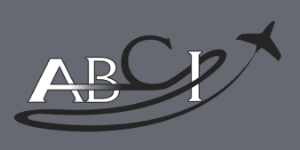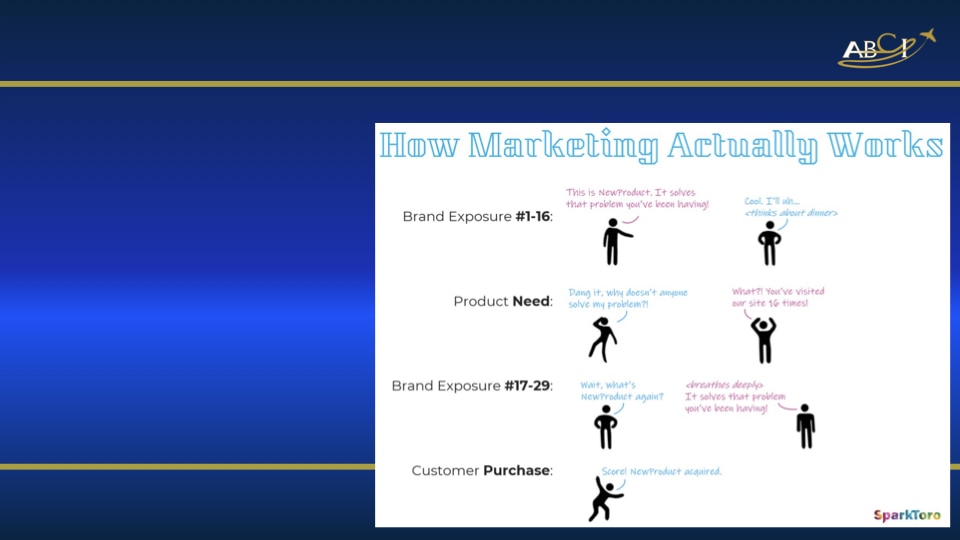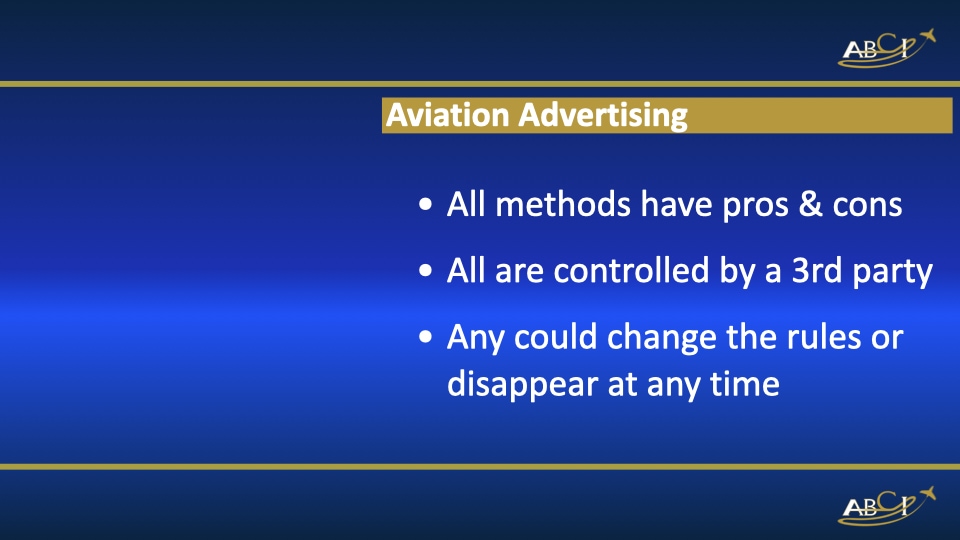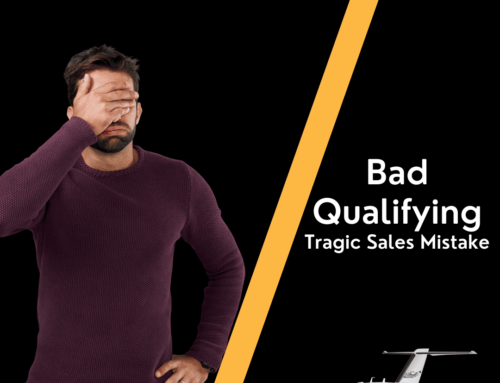Aviation advertising – there are SO many more options than when we first started talking about it in 2006.
But the fundamental principles are the same!
John and I discuss three key changes and three key success factors for aviation advertising in the post-covid market!
Transcript – Aviation Advertising – Three Things that Have Changed
Paula Williams: Welcome to this week’s episode. I am Paula Williams.
John Williams: And I am John Williams.
Paula: And we are ABCI and ABCI’s mission is…
John: To help all you ladies and gentlemen out there in the aviation industry, sell more of your products and services.
Paula: Absolutely. And that includes marketing, and part of marketing is advertising. So, we did an article, a million years ago, about aviation…
John: Wait, we have been around that long?
Paula: We have. In aviation years, yes, we have been around a million years. But there is an article that is way old. I believe it is from 2008.
John: Yeah.
Paula: Yeah, about aviation advertising and it got a lot of attention, which is great, and it is still getting a lot of attention, but it is getting embarrassing. Just because it has been so long and because so many things have changed. And actually, there are a lot of things that have not changed but just the quality of the video is pretty awful and it is pretty…
John: So you are going to replace it with this one?
Paula: Indicative, no. I am just going to add this one to it. We never replace anything. We always add because there is a historical record and that is a good thing. Besides, some people binge-watch our old videos. It is the weirdest thing I have ever heard. But anyway, I think that they just want to laugh at all the things that have changed.
John: Well, they can do that.
Paula: Audio and video quality from that long ago. But here we are in 2021 and if you are listening to this in 2041, and it is time to redo this again. But we wanted to talk about aviation advertising, which is an important part of marketing. And in fact, I think in a lot of people’s minds, they are mashed together into one big chunk of stuff, right?
John: Yeah, probably.
Paula: So this is a script of a skit that was done on a whiteboard by Rand Fishkin at SparkToro, and we are going to act it out.
John: We are?
Paula: Yes.
John: Okay.
Paula: Drama school, all right?
John: I am not an actor.
Paula: Okay. So this is a play in four parts. So I am going to be Character 1 and you are going to be Character 2, okay?
John: Okay.
Paula: So I am the person selling, you are the person buying.
John: Really?
Paula: Mm-hmm. Okay. So brand exposure number one, “This is a new product. It solves that problem you’ve been having.”
John: “Really? I’ll keep that in mind.”
Paula: Brand exposure number two, “Oh, hey. Look! A new product.”
John: “Uh-huh. New products again. I should check ’em out.”
Paula: Brand exposure, number three, or actually, this is the time of product need.
John: “It really needs to solve this problem. Let me see if that new product really can help.”
Paula: “Right this way, my friend.”
John: “Uh-huh, score, new product, acquired. Problem solved.”
Paula: “And everybody goes home happy.” Right?
John: Cheer.
Paula: Right. So four brand exposures and the product was purchased, everybody’s happy. That never happens.
John: No. Or if it does they were in order to taker and you did not really need to be advertising anyway.
Paula: Exactly. This is why people have to invest in advertising. This is how advertising actually works in the real world.
Okay. So once again, this is enacted four parts, but pay attention to how many brand exposures there are in each of these parts, right? Okay. Brand exposure 1 through 16. “This is a new product. It solves that problem you have been having.”
John: Uh-huh. Thinking about dinner. Time to have dinner.
Paula: Exactly.
John: Why does not anybody saw my problem?
Paula: Yeah. What? You visited our website 16 times.
John: Wait. What is that new product again?
Paula: It solves that problem you have been having.
John: Score. New product acquire.
Paula: So that was over 29 brand exposures and this is for a retail product. Rand Fishkin, [inaudible] He works with most companies with a lot of different companies. So if you are thinking about business-to-business, it’s even more than that.
John: Yeah. We had a slide once upon a time. You do not really get anybody’s attention till after the 12th…
Paula: Or more.
John: …or more contact.
Paula: That is true. And this is exactly the same thing except that it is worse now.
John: And most salespeople will not call you back three times.
Paula: Exactly. And most people stop advertising or they feel, “Well, they already know about my product. So there is no reason to keep advertising to the same people over and over again, to keep sending the same postcards or sending the same social posts, emails.”
John: Well, my personal experience from the customers I have was, I talked to some people about a new airplane, small one, 172, and as I now send you a postcard. When I said, “Tell me I got the card.” Well, life happens, it went away. What is happening…
Paula: You are thinking about dinner?
John: Whatever. Best process happened monthly for six months. Now, the last time I got the cards at Bennett and I made a phone call and we ended up on an airplane.
Paula: Right. So the larger the product, the more complicated the product, the more people involved in the buying decision, all of that adds time and exposures over time. And what has happened between 2010 when we started using the slide that John is talking about, and this slide here is that there is more advertising in everybody’s life than there was 2010.
John: And it was not because I did not want to buy the product. I really did and I needed to talk to the guy but life kept keeps getting in the way.
Paula: Yeah. It is not like they are sitting around waiting for you to…
John: Exactly.
Paula: …put an ad in front of them. Thing number one, most people do not pay attention to ads to begin with, unless it resonates in some way. So it is got to be a good ad. And thing number two is it has to be repeated. So even though it may not have worked in times 1 through 17 or 21 or 29 or 30, that does not mean it is not a good ad.
John: Right.
Paula: So statistically speaking, you can split test and see if one is 29 times in the other 17 times and take the one that has got a shorter sales cycle for you, but…
John: But it may have just been the people’s lives at the time.
Paula: A lot of this has nothing to do with you as the advertiser. Does not matter what I did. I was not going to get his attention until he was ready.
John: Right.
Paula: Not without tripping him and dragging him off by the hair to look at a presentation and we cannot do that in this industry. Actually, I do not know of any industry in which we can do that.
John: No.
Paula: Okay, cool. So that is where we are coming from, and our motto and this is something that somebody said about us and we really liked, was that we are respectfully relentless and that is absolutely true.
If there is somebody that we want is a customer, we do not give up on them until they opted out, which they usually do not do. We do not have very many opt-outs.
John: No.
Paula: But we keep sending them emails. We keep sending them packages in the mail. We keep sending them postcards. We keep doing all of those things. We keep producing podcast episodes. All of those things because we want to be relentless. We want to be in their face in a helpful way all the time.
John: Because someday they got to say, “Hey, I need to talk to you guys.”
Paula: Yeah, exactly.
John: I want to be there when I say that.
Paula: Right. So what is it? Chance favors the prepared mind.
John: It is exactly right.
Paula: We want to be the one that they have heard about last when they need to do some marketing.
John: That was a line out of the movie, actually.
Paula: Chance favors the prepared mind. I think that was Shakespeare.
John: Well, maybe, but I last saw in the movie.
Paula: Of course. Yeah. Anyway, there is a lot of things about Shakespeare that end up in movies. Yeah. Okay. So what is the best aviation advertising method?
John: Market. Marketing.
Paula: Thank you. Thank you for saying that. Yes, it should be a marketing campaign. Random acts of advertising are not going to do you any good whatsoever. So, yes, it is absolutely is true.
John: And more companies than ever are doing random acts of marketing and just throwing money down the toilet.
Paula: Absolutely. It is because it is easy to do. All of this social media channels provide a lot of opportunities to part you with your money and make you feel you are doing some good because you are getting clicks and likes and other things that do not really translate to…
John: Sales.
Paula: …sales. Right.
John: Exactly.
Paula: So you do need to do a well-thought-out campaign and you do need to be respectfully relentless in the process. All of the methods that you might use in an advertising campaign have pros and cons, which is why we like to use more than one of them in every campaign. All of the advertising media that I know of are controlled by a third party with the possible exception of maybe, like this podcast, which has a number of facilitators, like Libsyn and WordPress, and other technology bits and things like that. But we control the content, we own the content. We control the distribution. We control everything about it using these different tools. But almost every other advertising venue is controlled by a third party, by a magazine, or by a social media platform, or by a tradeshow sponsor, or an association or whatever. Right?
John: Uh-huh.
Paula: And the thing about anything that is controlled by a third party…
John: Cannot count on it.
Paula: …is that any of them could change the rules or disappear at any time. We learned that last year with COVID. A lot of people really depend on trade shows and trade shows did not happen.
John: Right.
Paula: If you are depending on any one thing for your marketing or advertising, you are really…
John: SOL.
Paula: You are really basing your business on a house of cards, right? Or on a… What is it building on sand. I guess is the biblical description of building your house on sand versus building your house on rock.
John: Whatever.
Paula: If you are only using any one advertising venue, no matter how well it is performing for you today, you really need to be looking at others as well.
John: Yes.
Paula: All right. So let us look at some of the more popular ones and see some of the pros and cons and put some combinations together that we have found to be really cool. So this is a grid that is going to make you dizzy. But one of the things that you can see here is that not anyone is a hundred percent advantageous across the board, right?
John: Yes.
Paula: They all have at least one disadvantage. Most have disadvantages or at least semi disadvantages when you look at it. So, social media is pretty cool for lots of reasons. But not all of these reasons weigh equally right?
John: No.
Paula. But some of the things that are a detriment to it like social media is a little bit less credible. If you are doing a social media campaign is an example, you want to pair it with maybe a direct mail campaign which covers its weak spots with something that is very, very strong because direct mail is super credible. It is probably the most credible of the media out there depending on how it is done. Any of these, there is a lot of variation but and any generalization is going to be somewhat falls in the right circumstances. It is all rule of thumb but this is a nice way to think about it. You want to pair at least two of these methods for any type of advertising that you are doing for any type of a marketing campaign. Is that makes sense?
John: Preferably three.
Paula: Preferably three. Our favorite is to use three.
John: Because that way, you can cover all the squares with the green piece somewhere.
Paula: Exactly. We like to use two electronics and one non-electronic media for any campaign that we are putting together. Depending on who we are trying to reach and how that works. For a flight school and we are advertising to high school graduates. Then we are going to take a different tack than someone who is looking to sell a Lear 45.
John: Right.
Paula: Those are completely different markets. So we would use different media in different ways but we still would pick three, right? There is not anyone sure-fire away to reach all high school seniors. There is not anyone sure-fire away to reach all people who have a nostalgic yen for Lear 45.
John: Right.
Paula: So all of those things have had their pros and cons. One of the lines that gets a lot of attention is the expense line. In fact, that is why we put those two on the bottom because people will tend to look at the bottom line, right? And expense and credibility are two of the biggest factors. If the rest do not mean a whole lot to you or you can go either way on any of those expenses and credibility. Those are the two that you really want to look at. And unfortunately, there is none. But is really, really good for credibility and has low expense. I think that maybe just the nature of it. People understand that if you are investing in something that it is more credible. So that is just the nature of the media as they are. If you are spending a lot of money to be at a trade show, then everybody who is at that trade show suddenly has credibility that they would not have had otherwise.
John: Yes.
Paula: Same thing if you are advertising in a magazine, especially for new companies, startups, things like that. We often recommend affiliating yourself with a brand that is older and stronger and more known than yours. So then you can say as seen in aviation week or one of the really credible brands in the market or as seen at NWA[?]. You may want to pick very carefully. Your most credible market or your most credible advertising venue, and then pick two less expensive media to support it. And then you can put a lot of energy into the less credible ones and a lot of money into the more credible ones. That balances out and gives you those advantages without so many disadvantages. You cannot do all of the expensive ones. We get that. That would be silly and unnecessary.
John: True.
Paula: Yeah. Okay. Couple of things that have changed since the last time we put out an infographic like this, we separated paid search from SEO. The biggest difference between SEO and paid search is that SEO is a long-term strategy and paid search is a short-term strategy. You need both to be honest because you need both long-term and short-term strategies. So that line, our results visible this week. With SEO is going to take you potentially six weeks to show any kind of a difference that is really marketable or that is really going to make a lot of sales for you. But paid search, you did put together a campaign and have it launched this afternoon.
John: Right.
Paula: So…
John: Expensive though.
Paula: It is expensive and we do recommend it for things like events and also for those keywords that you have a lot of competition for. In fact, there is some older podcast that you listen to from us where we say never, never, never, never, never use paid search unless it is for an event or something that is a time to limited factor. That is not true anymore. There is so much competition in search that and so many people doing SEO that if all of your competitors are doing paid search and you are not, you are going to be losing out on a lot of business because that is how people look for people.
John: If you are sharp in SEO and you find a competitor that has sharper SEO, then you will be fighting him for the rest of the time your business.
Paula: Right. And we offer SEO services and so do all of the other aviation marketing companies. So it is a nice race that really makes us all better. But it does drive me crazy because we are always be encountered. It is a chess game for us and that is true and a lot of they are really competitive fields, like flight schools and FBOs and certain areas and other things like that. There is a bidding war for paid search. The way that you counteract that is you have a very high-quality website and then you will actually end up paying less for those keywords than your competitors.
John: Have these mother strategies you can do as well, but that is a start.
Paula: Exactly. You want to be paying less than your neighbors beginning a better result and you do definitely want to be included in paid search if three out of four of your neighbors are there…
John: Of course.
Paula. …or competitors are already there. So those are some big things that have changed. Once again, no method is perfect. People are always asking us for the magic bullet or the easy button or whatever. I just want to do one thing and sell my product. If we could do that, we would be making a whole lot more money than we are now.
John: Exactly.
Paula: Yeah. Any combination of these advertising platforms is more effective than the sum of its parts. So if you do a campaign that is email plus a postcard or trade show followed up by direct Mail. Any of these things in combination is a thousand times more effective. Maybe not a thousand times. I am exaggerating. It is quite a bit more effective than the sum of its parts because people need to hear from you multiple times. Just like we talked about in that little skit from Rand Fishkin. It is crazy and we like to use three plus for any campaign because that does cover the pluses minuses and without spending any more money than we absolutely have to, we can do a really, really effective campaign. Cool.
John: Yes.
Paula: All right. So thank you for joining us.
[END]
Podcast: Play in new window | Download
Subscribe: Google Podcasts | Spotify | Amazon Music | RSS













Leave A Comment